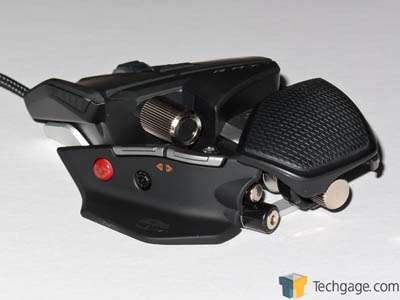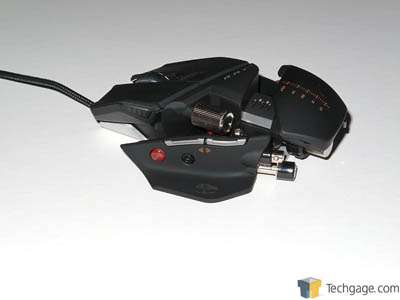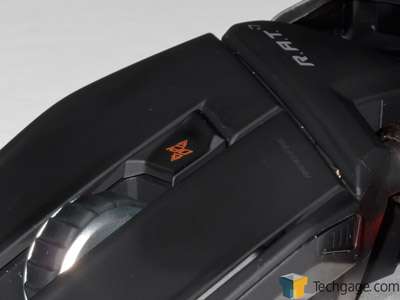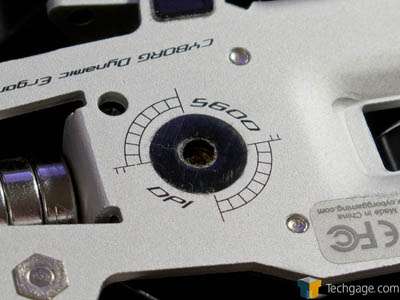- Qualcomm Launches Snapdragon 4 Gen 2 Mobile Platform
- AMD Launches Ryzen PRO 7000 Series Mobile & Desktop Platform
- Intel Launches Sleek Single-Slot Arc Pro A60 Workstation Graphics Card
- NVIDIA Announces Latest Ada Lovelace Additions: GeForce RTX 4060 Ti & RTX 4060
- Maxon Redshift With AMD Radeon GPU Rendering Support Now Available
Mad Catz Cyborg R.A.T. 7 Gaming Mouse
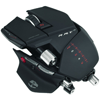
For the gamer looking to find a great mouse, the choices are limitless. But how often does one “feel” perfect? To cater to gamers who don’t mind taking time to customize a mouse to a huge degree, Mad Catz delivers its R.A.T. series. With full ability to customize both the body and software, R.A.T. could be perfect for everyone.
Page 3 – The Finer Details
The problem with these very high sensitivity mice is performing extremely precise actions, since even the slightest movement becomes amplified. Gamers often dropped the sensitivity during these precision moments, such as sniping, so they have finer control over aim. Sometimes this drop in DPI can be a problem when you need to quickly drop scope and pull a 180 to fend off an evil and quite literal back-stabber.
The little red button on the thumb rest is a temporary, low sensitivity mode which is only active while pressed, so if said back-stabber does come running, you don’t need to risk a fumble hitting the wrong button to bump up the DPI after a head-hunting spree.
This sniping button can be configured via software to control how precise the aiming mode becomes. It doesn’t give you direct access to a fixed DPI mode, but instead shows a percent reduction of the current DPI level. My guess would be that this is a software based option, since the button does not function without the drivers and software installed.
In theory, this can be an invaluable feature, as it’s use can be extended beyond games and into graphic design, for example, allowing for extreme precision at the touch of a button.
In practice however, there is a bit of a problem. The button itself is very firm and requires a fair bit of effort to press. Couple this with the high sensitivity, a bit of jitter will occur as you try to use it, putting you a fair bit off target with the scope as you engage the sniper mode.
However, the thumb scroll is a joy to use. Like the sniper button, it has no function at all without the drivers installed, but when it is, it’s just as flexible as any of the other button since it can be programmed.
It’s solid metal with a very low activation threshold, so it can be spun quite easily. It would be nice if it defaulted to horizontal scrolling, but it’s simple enough to program.
The DPI switch behind the scroll wheel is not a single button, but actually rocks back and forward. There is a small lip on the back of it to give you something to pull on. Dropping the DPI is actually a little bit stiffer than increasing; not to mention louder (the click) for some reason.
When it comes to the laser sensor, there are a few considerations to make. The Phillips dual laser sensor used in the R.A.T. 7 and 9, has a well-known and documented problem regarding Z-axis shifting. Yes, mice only detect X and Y based movement, but when the mouse is picked up and placed back down again (Z axis), this can and often does result in a diagonal shift of the cursor on-screen – down and right each time.
This issue affects most mice that use this particular sensor, including the Razer Imperator. It can technically be fixed in future driver revisions, but so far, months after initial release, still no patch.
If you have the DPI set fairly high though, then this becomes a non-issue, as you will rarely need to lift the mouse. If you prefer low DPI and like to make big sweeping movements with your arm with frequent lifting, then this is very important to bare in mind.
There is one final problem regarding tracking. This is something that only shows itself after a fair bit of use. Around the sensor there is a small Teflon disc, possibly to help minimise friction, but it does come at a price. If you zoom in on the picture above, you’ll notice that a fair bit of dust has gathered around the inside of disc. As this builds up, it can interfere with tracking, often resulting in either jerky movement or – as happened to me a couple times, the cursor will only move in one axis.
This problem can probably be fixed by simply removing the Teflon pad or by regular cleaning. It’s still strange that a Teflon ring be placed directly under the sensor, as these feet often gather dust around its edges… but no matter, just clean it off every now and then.
Tracking in general is extremely good, providing you have a decent surface. While in use, it felt more accurate and predictable than some other mice I have used. Another known issue with this laser is that it can be extremely picky when it comes to surfaces. Any glossy surface will often result in zero tracking; this includes laminated and plastic surfaces. A number of surfaces were tested and the sensor performed best on fabric mats. While other mice have no problem tracking on this desk surface, the R.A.T. 7 wouldn’t do a thing apart from the odd violent wobble.
Also, keep in mind with these high sensitivity mice that they can become susceptible to desk vibration, so use a good, well-padded mouse mat if you can.
Next up, we’ll be taking a look at the software side of things.
Support our efforts! With ad revenue at an all-time low for written websites, we're relying more than ever on reader support to help us continue putting so much effort into this type of content. You can support us by becoming a Patron, or by using our Amazon shopping affiliate links listed through our articles. Thanks for your support!




